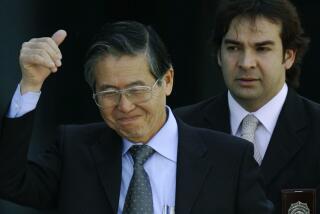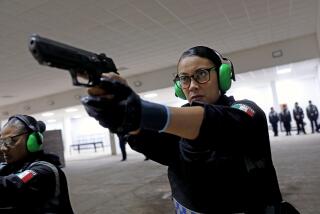For Philippines, a Dark Horizon for the New Year
MANILA — In 1987 the Philippines has suffered attempted coups, calamities and crises of often epic proportions. Grim evidence of the latest misery--the sinking of the ship Dona Paz with more than 1,500 souls aboard--was still washing up on island beaches at week’s end.
One tends to forget that 1987 began on a high note of hope for most Filipinos. A cease-fire agreement between the government and communist rebels had just been concluded. Until the first week of February, when the truce ended, Filipinos enjoyed a brief and fragile peace, a respite from the often brutal war of insurgency that has raged in this country for 16 years.
But the conflicts that had always torn at the political fabric of this fractious nation became more intense as the months wore on. At year’s end, that fabric is drenched in blood.
President Corazon Aquino has remained single-minded in implementing her timetable of setting in place the institutions of political democracy that her predecessor Ferdinand E. Marcos had discarded. But beyond the establishment of these formal structures--a constitution, a bicameral legislature--the Aquino administration has provided little in terms of democracy’s substance. The president, for example, surrendered the initiative for land redistribution to the debating halls of a conservative Congress. Moreover, her government has become increasingly susceptible to charges of corruption and a regression to the patronage-based politics of the past.
As the reformist image of the Aquino government is cracking, its pattern of governing has also come unravelled. For Aquino is a reactive president who takes decisive action only at the very peak of crisis. While such action brings renewed vigor to her administration, it is almost always followed by long periods of indecisiveness and drift until the next crisis comes along.
Following the August coup, for example, Aquino, in quick succession, reshuffled her Cabinet, increased the pay of soldiers and delivered tough speeches stating her intention to “govern directly.” After those moves, however, there have been no major new initiatives from her government.
It is a style of governing that tends to sweep problems under the carpet. Much, for example, has been made of the arrest earlier this month of the renegade Col. Gregorio (Gringo) Honasan, the leader of the bloody August coup. While the detention of the colonel and several of his key men precludes more takeover attempts in the near future, it does not eradicate the dangers posed by a politicized armed forces.
There are worries about the lingering “Honasan syndrome” within the ranks, especially among younger officers. The romanticized image of Honasan persists as a reform-oriented, if adventurist, officer who would bring deliverance from a government some in the armed forces perceive as weak, corrupt and unable--or unwilling--to fight the communists.
Military analysts say that the August coup, the bloodiest of five attempted against the government since it assumed power, exposed and deepened cleavages within the armed forces. The government tried to address the grievances of rebellious soldiers by, among other things, raising their pay and removing allegedly left-leaning Cabinet officials. But these changes do not seem to have wholly quieted restiveness in the barracks.
The retirement early next year of about a third of the military generals will mean the ascendancy of a younger, more politicized and more activist batch of colonels. This group is expected to assert the armed forces’ role in formulating security policy and also to articulate military sentiments on the conduct of government affairs.
The increasing role of the armed forces in defining government policy--and the pressure from rebellious military factions demanding that government take drastic steps it would otherwise not take--is a cause of concern among the administration’s more liberal and radical supporters.
Especially since the August coup, commentators focused on the Aquino government’s “rightward drift.” They noted the relegation into obscurity of what were, in the beginning, the government’s most remarkable features: the active defense of human rights, the espousal of negotiations with the communists and the crusading attitude toward social reform.
Meanwhile, communist rebels are intensifying the level of guerrilla warfare by conducting more offensives in the rural areas and more assassinations in the cities. The debate on tactics within the insurgents’ ranks, for now, appears to have been settled in favor of war rather than parliamentary politics.
Insurgent warfare is likely to intensify in the coming year as the rebels, in their public statements, speak of conducting more guerrilla actions on a larger scale in all parts of the country.
Last October, the communist New People’s Army killed three American servicemen outside Clark Air Base, a U.S. military installation. The killing of the Americans marked a new phase in the insurgency and is one of the indications of the escalation of guerrilla warfare.
There is likely to be more blood on the streets and villages in 1988 as guerrillas battle with soldiers. Civilians, too, are being drawn into the conflict with the government’s organization of anti-communist vigilante groups which have been mobilized to fight the insurgents.
In rural villages and city slums, where rebels are taking control, a deeper and more violent polarization is likely as the conflict intensifies and civilians are forced to take sides.
But at the moment, another kind of violence is holding the public’s attention. The Philippines is in the throes of yet another bloody election campaign, this time for local government officials.
Some 200,000 candidates are running in the polls scheduled next month. Already, the campaign death toll is rising. By mid-December, with only a quarter of the campaign period over, 22 people had been killed in election-related violence. The killings are expected to increase as the campaign peaks in the coming weeks.
In short, the outlook for the coming year is not optimistic. In many parts of the country, contending ideological and political forces appear to be on a violent collision course; within the Aquino coalition itself, a variety of groups and personalities are slugging it out in the contest for elective posts.
The coming year will be one of continued, if not heightened, conflict. More than ever, leadership is needed.
More to Read
Sign up for Essential California
The most important California stories and recommendations in your inbox every morning.
You may occasionally receive promotional content from the Los Angeles Times.










